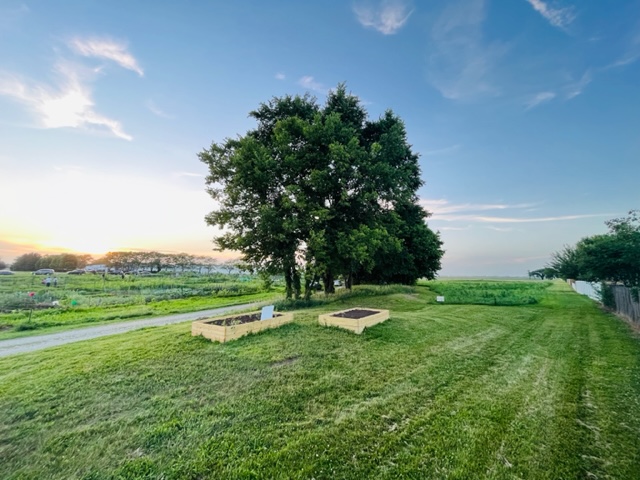
I love spring and love moseying around my yard, marvelling at the flowers popping through the mulch and the abundance of – are they pink, magenta, maybe even purple – or simply, redbud tree blossoms. There’s so much to be thankful for.
That being said, please take a few minutes with me to consider the suppression of this beauty. The culprit is grass.
It’s mid-April and I just mowed for the first time this year. Thankfully, over the last 5 years, I have slowly transitioned the lawn into mulched flower beds and raised vegetable beds – drastically cutting the square footage of space for my human powered, reel lawn mower. It may not be the cleanest cut, but it’s pollution free and a good workout.
There are empty lawn lots across this country. Much of it is public space, maintained by the city or state. There are some immaculate lawns full of fertilizer, herbicide, and perfectly mown lines – my favorite are the diagonal strips that make X’s. Like a baseball field ready for the World Series. But I’m not talking about the outfield of the St. Louis Cardinals.
You may not realize where these lots are in your city because they are so incredibly unremarkable. The purpose of these spaces is to keep the grass from getting too tall to not get a complaint. They are the kind of places that no one cares much about, so they are rarely used.
The funny thing is that they don’t serve much of a human purpose, but we, as humans, can’t help ourselves from mowing the spaces every week to literally kill any chance of other living things from finding a reliable food source and safe shelter. If non-human life do risk taking up residence, they’ll probably get killed by a mower blade or someone who decided that the dandelions simply cast too yellow a glow on the turf.
CNN reported in April 2022 that in Palm Springs, California, it takes 63,000 gallons of water per year to maintain the green in a 1,500 square foot yard. That’s not even a big yard.
I could go on with stats from various sources about the immense cost of maintaining a yard – Business Insider magazine reported in 2016 that Americans spend more than $30 billion/year on maintaining their yards. Some reporters describe lawn as the largest “cash crop” in the United States because of that expense. Not cash for the homeowners who spend hours and dollars to – it is very odd to say – “raise grass”, but cash for the companies that perpetuate the need for these great green monoculture carpets.
What is the benefit of this cash crop?
I think it has a lot to do with control, senseless social norms, and the fear of wilderness.
A couple years ago, my friend and I approached the Columbus, IN city airport about the possibility of adding native plant space to the AirPark. We identified an acre of space between the Columbus Community Garden and a nearby subdivision. Thankfully, the AirPark Director saw the vision of creating habitat using native plants in the space that was the type of mow over zone I’ve been describing. The Director understands that maintaining the grass is expensive and takes up the labor time of his staff.
I had no experience in converting grass to a native plant meadow, so I followed the suggestion of our local Sycamore Land Trust. We began with spraying the field with Roundup 2 times over the course of 4 months. In February, we broadcast 40 different native plant seed varieties across the area and let it grow until July. In July, it was moved to about an 8 inch height to knock down the weeds and give more light to the germinating seed.
Over Thanksgiving weekend, I went out into the field and did a 360 video of the space to send to my friend at the Land Trust. He was happy with the growth in the first year.
I brought to the field a large bin of harvested seed heads from my home. I added this seed to the edge near the bench we dedicated to my friend, Chelsea. It is exciting to have an acre that is growing wild in our city. I’ll do my best to protect the space from the temptations of turning it back into lawn. I know nature will throw flowers in the air where I had thrown down my seed. A colorful magic trick.
On Easter weekend, I walked the perimeter. It’s early in the season and there is hope already beginning to buzz across the acre. The city’s garden plots, just steps away, will be planted soon. The enhanced pollinator life in the field holds great promise in producing more bountiful yields for the gardeners.
It’s good to go a little wild. Caring for the environment is not about outcompeting your neighbor for the greenest lawn. It’s more about making a little more room for life and creating ecological landscapes that thrive with diversity.
Walking acre edge
Fall’s brown lingers, spring’s green shows
What grows next, who knows?

Recent Comments